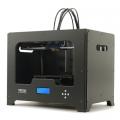Results 11 to 17 of 17
Thread: ABS+PLA flashforge
-
07-20-2015, 10:29 AM #11
this is where I get really confused lol
PLA is just so easy to use and totally forgiving on temps, things it'll stick too etc.
Whereas abs was alway a pain. Could never print anything without a raft, dimensions were never quite right, warped, cracked, smelt and forced you to always have acetone fumes around.
Both abs and the pla I like best, are made by same people: reprapper tech.
The reprapper pla is tougher than the abs, totally not-brittle, not quite as flexible as the abs - but certainly flexible enough for everything I've tried it with. And prints at the dimensions I design the models to.
Only smells of maple syrup, doesn't need acetone.
Abs parts I've made for a really tight fit generally crak where pla parts with same settings give enough to snapfit.
It really is weird I seem to have totally different experiences to everybody else.
Have never drilled pla - or abs - always put any holes in the designs.
So can't comment on that.
-
07-21-2015, 12:33 AM #12Student

- Join Date
- Jul 2015
- Posts
- 8
As pictures are better than words, you will find some screenshots here.
apparently, there's no convex issue, but all the PLA prints have holes on top of them although this is not the case for ABS print.
it's probably normal as simplify3d PLA profile is different than ABS one (in the screenshot also)
for info, in the screenshots,
D means "right extruder" and G means "left extruder".
the white box is ABS. orange and red are PLA (diameter is perfectly 1.75mm for both of them)
https://goo.gl/photos/wbdwUib9xKLSsVe19
Seb
-
07-21-2015, 01:22 AM #13
You should not be getting gaps like that!
I can't say much about S3D as I use Makerware but something's not right. What speeds are you printing at?Last edited by Sebastian Finke; 07-21-2015 at 01:27 AM.
-
07-21-2015, 03:01 AM #14Student

- Join Date
- Jul 2015
- Posts
- 8
-
07-21-2015, 04:12 AM #15
The extrusion multiplier is determined by the effective diameter of the filament drive gear. For example: if your extruder stepper is running at 30r/min and your filament drive gear has a diameter of, say, 20mm and you are using 1.75mm filament then your peripheral speed is
π x d x r
= 3.142 x (20 + 1.75) x 30
= 2050.155mm/min.
This peripheral speed is equal to the speed that the filament is fed into the nozzle. The extrusion multiplier is a factor/percentage of this speed. In a perfect world this should be 1 but several factors can affect it:
1) the filament is pressed into the filament drive gear thus reducing the effective diameter. And since all plastic have different densities they pressed into the gear to varying degrees resulting in different values for each plastic.
2) The filament drive gears can vary in diameter. Treat each gear as an unknown until calibrated.
3) Filament diameters vary, also varying the effective diameter.
4) Nozzle back pressure causing miniscule slipping
5) Friction (in filament guide tube, spool on spool holder, etc) causing miniscule slipping.
You can measure the filament diameter and the filament drive gear diameter. Determining how much of the filament is pressed into the gear is a bit of a shot in the dark, same goes for determining slippage due to back pressure due to slippage and friction. Hence the calibration process.
The extrusion multiplier allows you to adjust for all these factors. The calibration box is a visual test but serves its purpose well enough. A more scientific approach would be to do an immersion test of several items to determine the true volumetric output of the extruder.Last edited by Sebastian Finke; 07-21-2015 at 09:24 AM.
-
07-21-2015, 04:58 AM #16Student

- Join Date
- Jul 2015
- Posts
- 8
thanks a lot for this complete explanation Sebastian.
I find it really interesting, and think can help to limit the issue I get on the top of the box, but I'm still wondering why my print still stucks when printing in dual extrusion. I found a new menu in simplify 3d (dual extrusion wizard), and I will have a look today. maybe it will solve this problem.
thanks
-
07-22-2015, 05:58 PM #17Student

- Join Date
- May 2014
- Posts
- 35
You can't print PLA on top of ABS and vice versa, if that's what you're trying. From your description "the first layer of PLA is ok, then when it switch from ABS to PLA again, ..."
If instead you mean you always have trouble when changing from ABS filament to PLA filament, likely you have a small amount of ABS still in the extruder and the PLA temperature is not hot enough to push it through. Preheat extruder to ABS temp and push through PLA to push through any leftover ABS, then back down temp to appropriate PLA temp. If extruder is blocked by ABS, pushing melted PLA into the blockage will cause it to back up into the PET.
Also, when you say filament is blocked between PET and extruder, I can tell you on my FlashForge, the two extruders are not perfectly level. So, if you're running both extruders and one is putting down a higher level of plastic than the other, quite possibly the plastic in the lowest extruder is right up against the higher layer of plastic from the higher extruder, and with no where to go, the plastic is backing out into the PET. I haven't dual extruded yet, but I can tell you I have to relevel the bed when switching from left to right extruder use and vice versa.Last edited by AmyInNH; 07-22-2015 at 06:15 PM.





 Reply With Quote
Reply With Quote





Extruder not feeding during print,...
Yesterday, 02:02 PM in Tips, Tricks and Tech Help